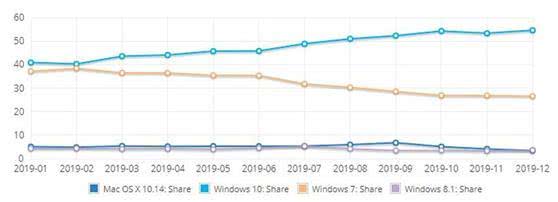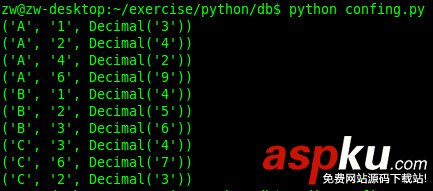来一个简单的例子,看Python如何操作数据库,相比Java的JDBC来说,确实非常简单,省去了很多复杂的重复工作,只关心数据的获取与操作。
准备工作
需要有相应的环境和模块:
- Ubuntu 14.04 64bit
- Python 2.7.6
- MySQLdb
注意:Ubuntu 自带安装了Python,但是要使用Python连接数据库,还需要安装MySQLdb模块,安装方法也很简单:
sudo apt-get install MySQLdb
然后进入Python环境,import这个包,如果没有报错,则安装成功了:
pythonPython 2.7.6 (default, Jun 22 2015, 17:58:13) [GCC 4.8.2] on linux2Type "help", "copyright", "credits" or "license" for more information.>>> import MySQLdb>>>
Python标准的数据库接口的Python DB-API(包括Python操作MySQL)。大多数Python数据库接口坚持这个标准。不同的数据库也就需要不同额模块,由于我本机装的是MySQL,所以使用了MySQLdb模块,对不同的数据库而言,只需要更改底层实现了接口的模块,代码不需要改,这就是模块的作用。
Python数据库操作
首先我们需要一个测试表
建表语句:
CREATE DATABASE study;use study;DROP TABLE IF EXISTS python_demo;CREATE TABLE python_demo ( id int NOT NULL AUTO_INCREMENT COMMENT '主键,自增', user_no int NOT NULL COMMENT '用户编号', user_name VARBINARY(50) NOT NULL COMMENT '用户名', password VARBINARY(50) NOT NULL COMMENT '用户密码', remark VARBINARY(255) NOT NULL COMMENT '用户备注', PRIMARY KEY (id,user_no))ENGINE =innodb DEFAULT CHARSET = utf8 COMMENT '用户测试表';INSERT INTO python_demo(user_no, user_name, password, remark) VALUES (1001,'张三01','admin','我是张三');INSERT INTO python_demo(user_no, user_name, password, remark) VALUES (1002,'张三02','admin','我是张三');INSERT INTO python_demo(user_no, user_name, password, remark) VALUES (1003,'张三03','admin','我是张三');INSERT INTO python_demo(user_no, user_name, password, remark) VALUES (1004,'张三04','admin','我是张三');INSERT INTO python_demo(user_no, user_name, password, remark) VALUES (1005,'张三05','admin','我是张三');INSERT INTO python_demo(user_no, user_name, password, remark) VALUES (1006,'张三06','admin','我是张三');INSERT INTO python_demo(user_no, user_name, password, remark) VALUES (1007,'张三07','admin','我是张三');INSERT INTO python_demo(user_no, user_name, password, remark) VALUES (1008,'张三08','admin','我是张三');
Python代码
# --coding=utf8--import ConfigParserimport sysimport MySQLdbdef init_db(): try: conn = MySQLdb.connect(host=conf.get('Database', 'host'), user=conf.get('Database', 'user'), passwd=conf.get('Database', 'passwd'), db=conf.get('Database', 'db'), charset='utf8') return conn except: print "Error:数据库连接错误" return Nonedef select_demo(conn, sql): try: cursor = conn.cursor() cursor.execute(sql) return cursor.fetchall() except: print "Error:数据库连接错误" return Nonedef update_demo(): passdef delete_demo(): passdef insert_demo(): passif __name__ == '__main__': conf = ConfigParser.ConfigParser() conf.read('mysql.conf') conn = init_db() sql = "select * from %s" % conf.get('Database', 'table') data = select_demo(conn, sql) pass fetchall()字段特殊字符过滤处理
最近在做数据仓库的迁移工作,之前数据仓库的数据都是用的shell脚本来抽取,后来换了python脚本.
但是在把数据抽取存放到hadoop时,出现了一个问题:
由于数据库字段很多,提前也不知道数据库字段会存储什么内容,hive建表是以/t/n做分隔,这就导致了一个问题,如果mysql字段内容里面本身含有/t/n,那么就会出现字段错位情况,并且很头疼的是mysql有100多个字段,也不知道哪个字段会出现这个问题.
shell脚本里的做法是在需要抽取的字段上用mysql的replace函数对字段进行替换,例如,假设mysql里的字段是column1 varchar(2000),那么很可能就会出现有特殊字符的情况,在查询的sql语句里加上
select replace(replace(replace(column1,'/r',''),'/n',''),'/t','')
之前一直是这么干的,但是这样写sql特别长,特别是有100多个字段,也不知道哪个有特殊字符,只要都加上.
所以在python中对字段不加处理,最终导致hive表字段对应出现偏差,所以在python里从mysql查询到的字段在写到文件之前需要对每个字段进行过滤处理
看个例子,我就以mysql测试为例,首先建一张测试表
CREATE TABLE `filter_fields` ( `field1` varchar(50) DEFAULT NULL, `field2` varchar(50) DEFAULT NULL, `field3` varchar(50) DEFAULT NULL, `field4` varchar(50) DEFAULT NULL, `field5` varchar(50) DEFAULT NULL, `field6` varchar(50) DEFAULT NULL) ENGINE=InnoDB DEFAULT CHARSET=utf8;
有六个字段,都是varchar类型,插入新数据可以在里面插入特殊字符.简单插入条数据测试看看:
insert into filter_fields(field1,field2,field3,field4,field5,field6) VALUES('test01','test02','test03','test04','test05','test06');insert into filter_fields(field1,field2,field3,field4,field5,field6) VALUES('test11/ntest11','test12/n/n','test13','test14','test15','test16');insert into filter_fields(field1,field2,field3,field4,field5,field6) VALUES('test21/ttest21','test22/ttest22/ttest22','test23/t/t/t','test4','test5','test6');insert into filter_fields(field1,field2,field3,field4,field5,field6) VALUES('test21/rest21','test22/r/rest22/r/rest22','test23/r/r/r','test4','test5','test6'); 其中数据里插入的特殊字符,可能连在一起,也有不连在一起的.
python测试代码:
# coding=utf-8import MySQLdbimport sysdb_host = '127.0.0.1' # 数据库地址db_port = 3306 # 数据库端口db_user = 'root' # mysql用户名db_pwd = 'yourpassword' # mysql用户密码,换成你的密码db_name = 'test' # 数据库名db_table = 'filter_fields' # 数据库表# 过滤sql字段结果中的/t/ndef extract_data(table_name): try: conn = MySQLdb.connect(host=db_host, port = db_port, user=db_user, passwd = db_pwd, db = db_name, charset = "utf8") cursor = conn.cursor() except MySQLdb.Error, e: print '数据库连接异常' sys.exit(1) try: sql = 'select * from %s;'%(table_name) cursor.execute(sql) rows = cursor.fetchall() print '====字段未过滤查询结果====' for row in rows: print row print '====字段过滤之后结果====' rows_list = [] for row in rows: row_list = [] for column in row: row_list.append(column.replace('/t', '').replace('/n', '').replace('/r', '')) rows_list.append(row_list) print rows_list[-1] # [-1]表示列表最后一个元素 return rows_list except MySQLdb.Error, e: print '执行sql语句失败' cursor.close() conn.close() sys.exit(1)if __name__ == '__main__': print 'begin:' rows = extract_data(db_table) pass 看看输出结果:
字段未过滤查询结果
(u'test01', u'test02', u'test03', u'test04', u'test05', u'test06')(u'test11/ntest11', u'test12/n/n', u'test13', u'test14', u'test15', u'test16')(u'test21/ttest21', u'test22/ttest22/ttest22', u'test23/t/t/t', u'test4', u'test5', u'test6')(u'test21/rest21', u'test22/r/rest22/r/rest22', u'test23/r/r/r', u'test4', u'test5', u'test6')
字段过滤之后结果
[u'test01', u'test02', u'test03', u'test04', u'test05', u'test06'][u'test11test11', u'test12', u'test13', u'test14', u'test15', u'test16'][u'test21test21', u'test22test22test22', u'test23', u'test4', u'test5', u'test6'][u'test21est21', u'test22est22est22', u'test23', u'test4', u'test5', u'test6']
可以看到,制表符,换行符,回车都被过滤了.
建议:最后说点题外话,不要小视/r,回车符.很多人以为回车符就是换行符,其实不是的,/r表示回车符,/n表示新行.之前代码里其实是过滤掉了/t/n的,但是抽取的数据还是不对,后来看了源码之后才发现,原来是没有过滤/r,就这个不同导致了很多数据抽取不对.



















